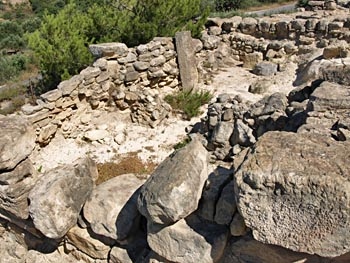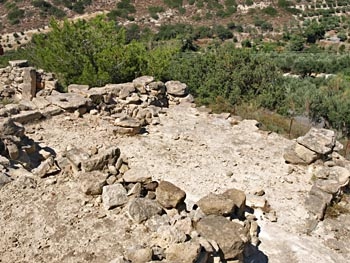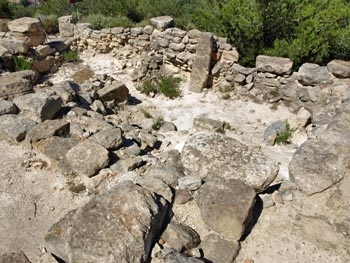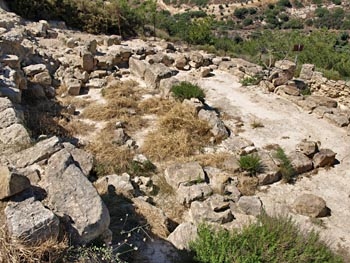A neopalatial villa
The country house near the village of Zou, south of Siteia, was discovered and excavated by N. Platon over two seasons in the 1950s. Part of the site was unfortunately destroyed when the road to the village was built, but a significant building was uncovered. The existence of other buildings nearby suggests a settlement rather than an isolated country house. The house was built on terraces up the side of the hill. Some of the rooms had basements but although the building was constructed on terraces it was the opinion of Platon that it was only a single storey building. Nevertheless it contained at least 20 rooms built on the five different terrace levels. In places, two architectural phases have been detected.
The dating of the villa is based on ceramics found inside the remains of the building and in particular in three deposits in room Zeta (see plan). These finds show that the villa was built in the MM IIIB period (i.e. neopalatial) and that it remained in use for a very short period, at the latest into the LM IA period. It seems to have been destroyed at the same time as the villa at Klimataria and the building at Patelas Sfakion, also in the Siteia region. Further evidence for a destruction in this period comes from the Piskokefalo peak sanctuary which seems to have gone out of use in MM IIIB. The evidence from Zou, in the form of distorted walls and damage to ashlar masonry in rooms Delta (Δ) and Epsilon, suggests that an earthquake was most likely responsible for the destruction.
A large part of the building was constructed using sizeable blocks of ashlar masonry. The rooms on the lowest level of the building were destroyed by the construction of the road. These include parts of rooms Alpha and Beta. Because room Gamma (Γ) is much deeper than rooms Alpha and Beta it is hypothesised that there were two other rooms, one to the east of Alpha and one to the east of Beta, which now lie under the road. Virtually the whole of room Gamma (Γ) and the entrance and some of the steps leading to rooms Kappa and Zeta as well as the facade of the building were probably also destroyed. The building as it stands today measures 31 metres by 23 metres, giving an area of over 700 square metres. But it was very likely much bigger than this since the northwest and southeast boundaries of the site could not be definitely ascertained.
On the lowest level, room Alpha was excavated in the second season. The floor was discovered to be paved with stone slabs and remains of the destroyed east wall was found. The excavators also uncovered a good number of sherds from pots, jugs, cups and beakers as well as pieces of a cylindrical utensil with a rope decoration and a large part of a pithos. In room Beta, once the original floor level had been reached, a built hearth with ash and clear traces of fire was uncovered. In the middle of the north side, another built hearth with clear signs of fire was found extending to a low niche in the southwest corner. In room Gamma (Γ) the northwest corner of this almost totally destroyed room was investigated. Sherds of beakers, cups and jugs were found. On the west wall of room Gamma (Γ), a series of four small cupboards separated from each other by walls were identified but only parts of two of them (Zeta 1 and Zeta 2) were preserved. These had been investigated the previous year from room Zeta, to which they seem to belong and they are discussed more fully below together with room Zeta.
On the next level up, an entrance, on the east side of the building, led into an oblong room (Kappa). By the entrance there is a square area with a window, a paved floor and two benches. From here the room becomes a sort of hallway from which a double door opens into the next room (Zeta) which was used as a kitchen and a workroom. A narrow set of steps of which only the base remains led to the double doors. Given the usage of room Zeta the excavator suggested that this east entrance may have been the service entrance to the villa through the small area Kappa, then into the hallway and from there into room Zeta. According to the excavator, if the main entrance was on the east it is likely to have been further northeast with an entrance into a hallway leading to rooms Gamma (Γ), Beta and Alpha which were the rooms destroyed by the construction of the road.
The kitchen/workroom
The largest deposits of finds on the site were uncovered in the kitchen/workroom Zeta. A lot of kitchen ware as well as loomweights were found in the room. Other objects included many pestles and similar stone tools as well as two trough-like stone objects, both of which had spouts on one side and may have been used as olive presses. Inside the room, built in the north corner, was a square area which contained small pithoi, various pots, jugs, amphorae, bowls, etc. The decoration of these vessels dated them to the MM IIIB period. One of the more notable finds was a vessel with filters and a small lid with a curved handle.
Four smaller storage compartments are connected to the room against the north east wall and may originally have been part of room Gamma (Γ). Some of these compartments were full of plain pottery. A decorated vessel with feet and an internal filter as well as some bridge-spouted jugs decorated with a series of double axes were found. The vessels were dated to the transition between MM IIIB and LM IA. A layer of ash 0.30 metres thick under the side walls of these storage compartments suggested to some that they had been constructed after destruction by fire at an earlier stage. However Platon seemed to think that one or more of the small "cupboards" had in fact been used as a ceramics kiln, the entrance of which was from the kitchen/workshop room Zeta. The entrance to the four "cupboards" was blocked, a well-known measure taken after the vessels were placed inside the kiln.
Next to room Zeta were two rooms (Delta (Δ) and Epsilon). Only the basement level of these rooms is preserved. From the remains of the northeast walls it is clear that the floor of the upper rooms would have been level with the floor of room Zeta. The descent into room Epsilon would have been via some steps, of which only the base, carved into the rock, still remains. The most commonly used entrance into room Epsilon was from the narrow, oblong room Iota through a small hall and then down some steps, the remains of which were carved into the soft rock. Room Iota also communicated with room Zeta down a set of four steps and with the buildings on the higher terrace through a door at the north end of the west wall. Inside room Epsilon an oblong piece of ashlar masonry, possibly the threshold stone or lintel from a doorway, was found out of position. Room Delta (Δ) was divided in two by a wall which did not, however, create two separate rooms. There were two windows in the north wall, one either side of the partition. Room Delta (Δ) also contained a hearth in the north corner while a square piece of slate, possibly the base for a pithos, was found in the northwest corner.
Internal courtyard
In rooms Theta (Θ) and Lambda (Λ) many walls had fallen and other walls had been added at a much later date. The northeast wall of room Theta (Θ) gives the impression that the upper and lower parts of the villa were built separately. Room Theta (Θ) was identified in the second season as being a small court with a retaining wall holding back the earth from the parapet of the higher level Theta 1 (Θ1). Steps up from Theta 1 (Θ1) to corridor Nu were located in the southwest corner. At the point where the steps would have reached the upper corridor a group of vessels was found including pieces of two amphorae with eliptical mouths, jugs, thin walled cups and a piece of a small pithos with rope decoration. In the courtyard yet another hearth was found. Later walls constructed over this area were removed and the finds among the stones of the building corresponded to MM IIIB-LM IA so its chronology was little different from that of the final destruction of the villa.
With the removal of the walls the strange construction in the northwest corner of Theta (Θ) became clearer. A hearth had been built occupying the original communication opening towards the small room Mα and this had its main opening towards the courtyard Theta (Θ) and a second one towards the neighbouring room. The use of this space for a hearth was confirmed by traces of fire in the narrow internal niche and from the two pots found inside.
Room Mα is even stranger. The room is paved and a large part of the room is taken up with an oval basin with upright slabs and with a slightly inclined bottom so that the contents can be emptied through a small drain leading across the paved floor. The basin was found completely empty and Platon suggests it might have had something to do with work carried out in room Lambda (Λ). Finally in the southwest corner of Mα where the hearth had been built, a large quantity of sherds were found including from cups, a pot and a pyxis.
Although it could not ascertained clearly if there was a doorway betwen Mα and Mβ due to the poor condition of the wall separating the two rooms, it was thought likely due to the fact that the basin virtually blocked off the entrance from Mα to room Lambda (Λ). Mβ seemed to be a hallway leading to room H in one direction and room Mα in the other. Slate covered the drain from the basin which followed the western edge of the room.
A possible shrine
Room H (Eta) was particularly interesting. The entrance in the northeast corner of the room is reached by a very short, narrow corridor. Stone pestles, sherds from the MM IIIB-LM IA period and a section of a rhyton in the form of an animal's head, possibly a bull, and a low, clay tripod table (possibly for offerings) suggest a ritual use for this room. Originally, there may have even been a pillar in the room. In the second season a clay lamp of protopalatial style was found.
Although situated further up the hill, the floor of room Lambda (Λ) was on the same level as the floor of room H (eta). Finds here were similar to those in other parts of the villa and were also dated to MM IIIB-LM IA. The most significant find of the excavation was uncovered here -- a sizable clay head of a man wearing a wide hat with a border round it and perhaps a central plume. The eyes were discs attached to the head using a technique of protopalatial idols. The body of the idol would have been at least 0.40 metre in height and so this would have been the largest idol from the height of the Minoan period whose head has been recovered. It is unlikely to have dated later than MM IIIA. Together with the head, the body of a small clay idol was also found. While most of the finds in room Lambda (Λ) clearly belonged to that room, Platon suggests that the idols might have belonged to an upper floor in this part of the building.
Another strange aspect of room Lambda (Λ) is the very low wall made up of stone slabs that leads from the basin in the southwest corner of the room, diagonally northwest until it reaches the doorjamb. The floor of Lambda (Λ) is natural rock and slopes gently but only the side to the east of this little wall seems to have been levelled off with soil.
The highest level lies west of corridor Nu and was possibly accessed by the staircase mentioned above. In Platon's view area Xi (Ξ), which consists of three walls with bedrock closing off the fourth side, was most likely an enclosed open air space, probably a place where animals were kept. The area had a wide door opening to the north.
About 150 metres away and further down towards the river bed some ashlar masonry from another large villa was found. The sherds found on the spot indicate that the building was contemporaneous with the excavated villa.
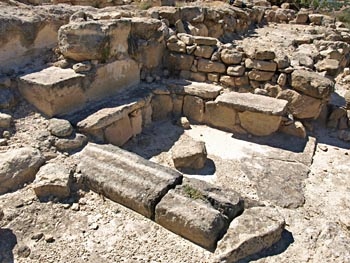 Room K seen from the side |
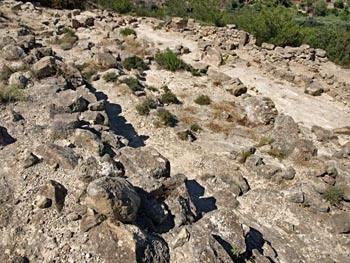
Lower terraces seen from above |


